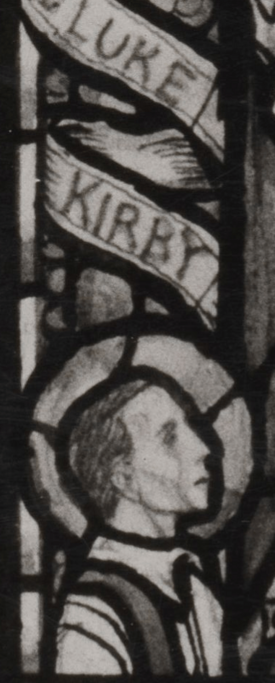Luke Kirby (priest) facts for kids
Quick facts for kids SaintLuke Kirby |
|
|---|---|

Detail of a sketch of a stained glass window for Notre Dame Convent, Wigan, England
|
|
| Martyr | |
| Born | c. 1549 probably near Richmond, Yorkshire, England |
| Died | 30 May 1582 (aged 32 - 33) Tyburn, London, England |
| Honored in | Roman Catholic Church |
| Beatified | 29 December 1886 by Pope Leo XIII |
| Canonized | 25 October 1970 by Pope Paul VI |
| Feast | 30 May (individual with his three companions) 25 October (with the Forty Martyrs of England and Wales) 29 October (one of the Douai Martyrs) |
| Attributes | martyr's palm, book of hours |
Luke Kirby (born around 1549 – died May 30, 1582) was an English Catholic priest. He was executed during the time of Queen Elizabeth I. He is remembered as one of the Forty Martyrs of England and Wales.
Early Life and Studies
Luke Kirby likely earned a master's degree in England, possibly at Cambridge University. He later became a Catholic while in Louvain, a city in Belgium. In 1576, he joined the English College, Douai, which was a school for English Catholics.
He became a priest in September 1577. He then tried to return to England in May 1578 but came back to Europe. In Rome, he took an important oath at the English College, Rome in 1579. While there, he met a person named Anthony Munday. Munday later gave false information about Kirby.
Journey to England
Luke Kirby was chosen to travel with two other priests, Campion and Ralph Sherwin, back to England. They left Rome in April 1580 and arrived in Rheims, France, in May.
In June, Kirby continued his journey to England with another priest, William Hartley. They walked all the way to the coast, passing through Douay and Dunkirk.
Arrest and Imprisonment
In June 1580, Luke Kirby was arrested as soon as he arrived in Dover, England. He was taken to a prison called the Gatehouse in Westminster.
Later, in December, he was moved to the Tower of London. There, he was put through a difficult experience known as the "Scavenger's Daughter" for over an hour. This was a form of torture used at the time.
Luke Kirby was tried in court at the same time as Edmund Campion. They were both accused of treason, which meant going against the Queen's rules. His execution was delayed until May of the next year.
Execution and Legacy
Luke Kirby was found guilty on November 17, 1581. From April until his death, he was kept in chains. He was executed on May 30, 1582, at a place called Tyburn in London. Two other priests, Thomas Cottam and William Filby, died with him.
Years later, in 1886, Pope Leo XIII recognized Luke Kirby and his companions as "Blessed." Then, in 1970, he was made a saint as one of the Forty Martyrs of England and Wales.
A special cloth called a corporal, kept at the English College, Rome, has Luke Kirby's name stitched into it. This cloth is a special item used in church services.
A book about his life, titled "Blessed Luke Kirby: Priest and Martyr," was written by Michael TH Banks. Also, a part of a stained glass window at St Edmund's College, Ware shows him.

